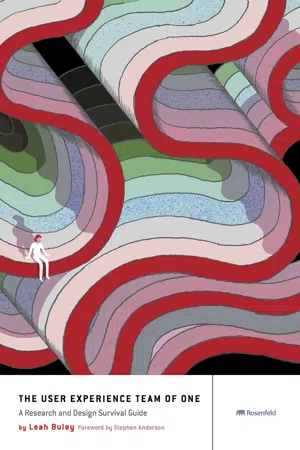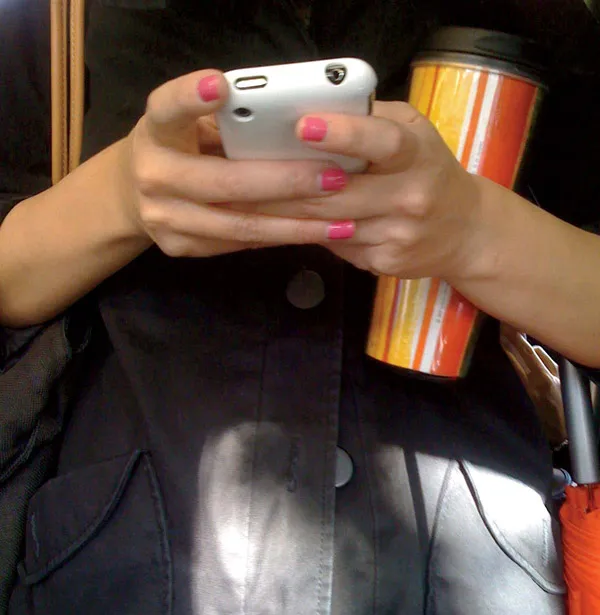
eBook - ePub
Available until 23 Dec |Learn more
The User Experience Team of One
A Research and Design Survival Guide
This book is available to read until 23rd December, 2025
- 246 pages
- English
- ePUB (mobile friendly)
- Available on iOS & Android
eBook - ePub
Available until 23 Dec |Learn more
About this book
The User Experience Team of One prescribes a range of approaches that have big impact and take less time and fewer resources than the standard lineup of UX deliverables. Whether you want to cross over into user experience or you're a seasoned practitioner trying to drag your organization forward, this book gives you tools and insight for doing more with less.
Frequently asked questions
Yes, you can cancel anytime from the Subscription tab in your account settings on the Perlego website. Your subscription will stay active until the end of your current billing period. Learn how to cancel your subscription.
No, books cannot be downloaded as external files, such as PDFs, for use outside of Perlego. However, you can download books within the Perlego app for offline reading on mobile or tablet. Learn more here.
Perlego offers two plans: Essential and Complete
- Essential is ideal for learners and professionals who enjoy exploring a wide range of subjects. Access the Essential Library with 800,000+ trusted titles and best-sellers across business, personal growth, and the humanities. Includes unlimited reading time and Standard Read Aloud voice.
- Complete: Perfect for advanced learners and researchers needing full, unrestricted access. Unlock 1.4M+ books across hundreds of subjects, including academic and specialized titles. The Complete Plan also includes advanced features like Premium Read Aloud and Research Assistant.
We are an online textbook subscription service, where you can get access to an entire online library for less than the price of a single book per month. With over 1 million books across 1000+ topics, we’ve got you covered! Learn more here.
Look out for the read-aloud symbol on your next book to see if you can listen to it. The read-aloud tool reads text aloud for you, highlighting the text as it is being read. You can pause it, speed it up and slow it down. Learn more here.
Yes! You can use the Perlego app on both iOS or Android devices to read anytime, anywhere — even offline. Perfect for commutes or when you’re on the go.
Please note we cannot support devices running on iOS 13 and Android 7 or earlier. Learn more about using the app.
Please note we cannot support devices running on iOS 13 and Android 7 or earlier. Learn more about using the app.
Yes, you can access The User Experience Team of One by Leah Buley in PDF and/or ePUB format, as well as other popular books in Business & Marketing Research. We have over one million books available in our catalogue for you to explore.
Information
PART I

Philosophy
What makes a team of one special is that you find yourself in situations where you not only see an opportunity for a more user-centered approach, but you also need to lead the charge, bringing others along with you. A team of one challenges the mighty forces of the status quo, inertia, and other people’s way of doing things. That’s brave and ambitious work, and it requires not only technical know-how but also vision, conviction, and a soft touch. This part of the book will arm you with all of the above. The approach outlined here can help you spread the growth of a new and exciting field, one person at a time.

PHOTO BY ANGELO AMBOLDI (FLICKR)
CHAPTER 1

UX 101
Defining User Experience
An Example
Where UX Comes From
Where UX Professionals Come From
If You Only Do One Thing...
Talking about user experience (UX) can be a bit like looking at an inkblot test: whatever matters the most to you ends up being what you see. People find their way to the field of user experience through a variety of pathways, and they naturally apply their own lenses in how they think about and describe the work of UX. This chapter will attempt to balance out the picture by giving you a simple definition of user experience to work with, a little more information about where it comes from, and an understanding of how it’s different from other fields.
Defining User Experience
User experience is a famously messy thing to describe. Many people have offered their own definition, and yet no single one has prevailed as the clear favorite. UX, it turns out, is a controversial concept. This is probably because “user experience” is a general term that describes not only a professional practice, but also a resulting outcome. To be a user experience designer means to practice a set of methods and techniques for researching what users want and need, and to design products and services for them. Through good UX, you are trying to reduce the friction between the task someone wants to accomplish and the tool that they are using to complete that task. The resulting user experience that someone has is determined by a multitude of factors so vast that no one person, team, or even technology can claim to be responsible for it (see Figure 1.1).

FIGURE 1.1
Often, the term user experience refers to the encounters that people have with digital products, like software or a Web app.
Often, the term user experience refers to the encounters that people have with digital products, like software or a Web app.
In a simple working definition, you might say that a user experience is the overall effect created by the interactions and perceptions that someone has when using a product or service (see Figure 1.2). User experience is a fancy term for what people often describe with words like “love” or “hate”; or phrases such as, it’s “easy to use,” or “a pain in the butt.” You may recognize user friendly as a term that has worked its way into popular usage. For example, when someone says a product is user friendly, he is basically referring to the user experience. Given that we transact so much of our lives through technology, how easy or difficult it is to use is what really matters. And that’s what user experience is all about.

FIGURE 1.2
User experience is not just restricted to what you do on your phone or your laptop. This shopping mall directory has an interactive user experience, which impacts how easily shoppers can find what they are looking for in their physical environment.
User experience is not just restricted to what you do on your phone or your laptop. This shopping mall directory has an interactive user experience, which impacts how easily shoppers can find what they are looking for in their physical environment.
As a field of professional practice, user experience encompasses several disciplines. The main contributors are user research and user experience design. User research is about understanding users and their needs, and user experience design is about designing a user’s interactions with a product from moment to moment. Lots of user experience professionals have one of those titles, but it’s also common to see people mixing and matching these terms into inventive but nonstandard titles like “user experience architect” or “user interaction designer.”
But there are other disciplines that certainly contribute to the resulting experience that a user has with a product, even if they may not fit as snugly into the job description of a user experience designer. These disciplines include visual design, content strategy, copywriting, business analysis, product management, project management, analytics, search engine marketing and optimization, brand marketing, and even engineering. In this field, there are lots of heated discussions about who gets to claim ownership of the user experience. Without fueling the flames, let’s just say that for the purposes of this book, if you do any of these things, you’re contributing to the user experience of your product, and this book is for you.
An Example
Personally, I think it’s easier to understand UX when you think about what it’s like to actually use a product. For example, right now I’m sitting in front of my computer, hopping around within the operating system and keying from my word processing program to my email program to my music program. My perception of each of those programs is impacted by how it looks, how it functions, and how well it serves its purpose in the personal need that it satisfies. (Helping me write a book; managing my personal and professional communications; and listening to some tunes that keep me tapping my feet as I work, respectively). In any of these programs, a thousand little decisions were made by someone—or more probably, many “someones”—to create what I experience as the flowing, seamless experience of working (see Figure 1.3).
And that’s just the software. My user experience is also impacted b...
Table of contents
- Cover Page
- Title Page
- Copyright Page
- DEDICATION
- HOW TO USE THIS BOOK
- FREQUENTLY ASKED QUESTIONS
- CONTENTS
- FOREWORD
- INTRODUCTION
- PART I Philosophy
- PART II Practice
- APPENDIX Guide to the Methods in Part II
- Index
- ACKNOWLEDGMENTS
- ABOUT THE AUTHOR